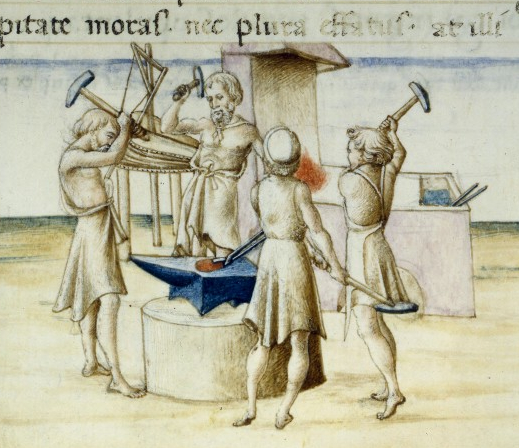A Layman's Understanding of Damascus Steel
By
Parker Brown
ARMA Denton, TX
 The
term "Damascus steel" can refer to two different types of ferrous
(containing iron) materials characterized by the watery pattern produced
from the controlled mixture and physical manipulation of the iron and
steel. Western Europeans were first introduced to this material around
the 3rd-4th centuries from the historical trading center of Damascus,
in present-day Syria. While there are examples of this material being
produced in Damascus itself, its technical and physical origins are from
India and the Middle East. Damascus steel is not to be confused with damascene,
which is a process of inlaying gold leaf onto the surface of steel for
the purpose of decoration. The
term "Damascus steel" can refer to two different types of ferrous
(containing iron) materials characterized by the watery pattern produced
from the controlled mixture and physical manipulation of the iron and
steel. Western Europeans were first introduced to this material around
the 3rd-4th centuries from the historical trading center of Damascus,
in present-day Syria. While there are examples of this material being
produced in Damascus itself, its technical and physical origins are from
India and the Middle East. Damascus steel is not to be confused with damascene,
which is a process of inlaying gold leaf onto the surface of steel for
the purpose of decoration.
Cast Damascus steel, known as wootz, was popular in the East.
It's produced by melting pieces of iron and steel with charcoal in a reducing
atmosphere (lacking oxygen). During the process, the metals absorb carbon
from the charcoal and the resulting alloy is cooled at a very slow rate.
This produces a material with a visible crystalline structure of varying
carbide contents. Forging the material into a desired shape (such as a
sword blade) alters the crystalline structure into the familiar waving
or watered pattern that Damascus steel is known for. This technique is
extremely work intensive and requires a high degree of skill to keep the
necessary temperatures constant throughout the process. The resulting
volume of material produced is substantial enough for a larger-scale production
house, but would be impractical for smaller individually produced pieces.
Fabricated Damascus steel, known as pattern-welded steel, was
more popular in the West and produced essentially the same product as
wootz with less labor and less yield. Layering two or more linear elements
of iron and steel and forge welding them together produced pattern-welded
steel. Forge welding requires the stacking of two pieces of metal and
hammering the two together while the whole is at a high temperature. The
surfaces of the individual metals are at the near molten state while the
core of the metal is still solid. By forcing the surfaces together at
this temperature (with the presence of a flux to seal the joint off from
oxygen), the result is a welded bond, essentially forcing the two metals
into one. Stretching out the length of the composite material and forge
welding it back onto itself results in multiple layers that can be manipulated
to produce the same watered pattern as wootz.
Besides their beautiful aesthetic appearances, both wootz and pattern-welded
steels produced a metal that was harder and more flexible than traditional
wrought iron. These features were critical in the making of a long bladed
weapon, such as a sword. While the use of wootz steel is primarily linked
to India and the Middle East, Norwegian smiths were masterfully producing
pattern-welded blades in the 6th century A.D., centuries before the famed
pattern-welded katana developed during Japan's Kamakura period (ca. 1185-1333).
However, despite its famed durability and quality, Damascus steel is a
relatively heterogeneous (unevenly mixed) material in comparison to modern
high-carbon steels produced using the 19th century Bessemer process. For
its time, it was a magnificent material that was costly and expensive
to produce and allowed smiths to produce quality long-bladed weapons.
Parker Brown is an apprentice armorer and proprietor
of Crescent
Moon Armoury.
|

